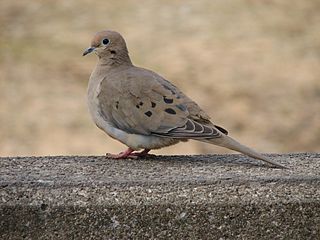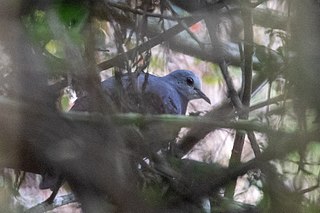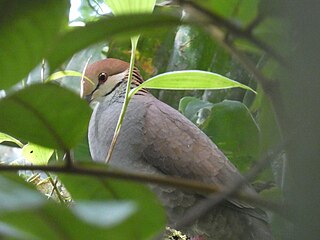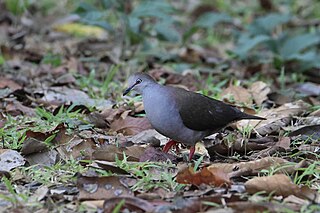
The eared dove is a New World dove. It is a resident breeder throughout South America from Colombia to southern Argentina and Chile, and on the offshore islands from the Grenadines southwards. It may be a relatively recent colonist of Tobago and Trinidad. It appears to be partially migratory, its movements driven by food supplies.

The zenaida doves make up a small genus (Zenaida) of American doves in the family Columbidae.

The Zenaida dove is a member of the bird family Columbidae, which includes doves and pigeons. It is the national bird of Anguilla, where it is locally referred to as "turtle dove".

The West Peruvian dove or Pacific dove is a species of dove in the genus Zenaida.

The maroon-chested ground dove is a species of bird in the family Columbidae. It is found in Bolivia, Colombia, Costa Rica, Ecuador, El Salvador, Guatemala, Honduras, Mexico, Panama, Peru, and Venezuela.

Geotrygon is a bird genus in the pigeon and dove family (Columbidae). Its members are called quail-doves, and all live in the Neotropics. The species of this genus have ranges from southern Mexico and Central America to the West Indies and South America. Quail-doves are ground-dwelling birds that live, nest, and feed in dense forests. They are remarkable for their purple to brown coloration with light-and-dark facial markings.

The grey-fronted quail-dove is a species of bird in the family Columbidae. It is endemic to Cuba.

The Tuxtla quail-dove or Veracruz quail-dove is a species of bird in the family Columbidae. It is endemic to southeastern Mexico.

The Chiriqui quail-dove or rufous-breasted quail-dove is a species of bird in the family Columbidae. It is found in Costa Rica and Panama.

The russet-crowned quail-dove is a species of bird in the family Columbidae. It is found in Panama and far northwestern Colombia.

The purplish-backed quail-dove is a species of bird in the family Columbidae. It is found in Costa Rica and Panama.

The lined quail-dove is a species of bird in the family Columbidae. It is found in Colombia, Trinidad and Tobago, and Venezuela.

The violaceous quail-dove is a species of bird in the family Columbidae. It is found in Argentina, Bolivia, Brazil, Colombia, Costa Rica, Guyana, Nicaragua, Panama, Paraguay, Peru, Suriname, and Venezuela.

Leptotila is a genus of birds in the dove and pigeon family Columbidae. These are ground-foraging doves that live in the Americas.

The grey-chested dove is a species of bird in the family Columbidae. It is found in Belize, Colombia, Costa Rica, Guatemala, Honduras, Mexico, Nicaragua, and Panama.

The Caribbean dove is a species of bird in the family Columbidae. It is found in Belize, the Cayman Islands, Colombia, Honduras, Jamaica, and Mexico. It has been introduced to the Bahamas.

The pallid dove is a species of bird in the family Columbidae. It is found in Colombia, Ecuador, and Peru.

The purple quail-dove is a species of bird in the family Columbidae. It is found in Colombia and Ecuador.

Columbinae is a subfamily of birds from the family Columbidae. Otherwise, four genera Geotrygon, Leptotila, Starnoenas and Zenaida form subfamily Leptotilinae.

Zentrygon is a bird genus in the pigeon and dove family (Columbidae). Its members are called quail-doves and all live in the Neotropics.
























